If you’re a middle or high school music teacher, then you know how important keeping your students on task can be. It’s important to have strategies in place for classroom management from day one so that everyone can have a productive and enjoyable year. In this blog post, I’ll discuss five easy strategies for classroom management in music class. These tips will help keep your students not only focused and engaged but help them feel respected.
Music Classroom Management Strategies

Have a Temporary Seating Chart & Learn Your Names ASAP!
One of the best things you can do for your students (and yourself!) is to learn their names as quickly as possible. A great way to do this is to have a seating chart on day one and keep it in place until you’re confident that you know where everyone belongs. Another strategy is to ask your students to wear name tags on the first day of class. This will help you learn their names more quickly and also let them know that you’re interested in getting to know them.
Once you know your students’ names, it’s much easier to keep them on task and manage your classroom effectively. When you can address each student by name, they’ll feel respected and valued as individuals. This will go a long way in terms of keeping them engaged in your class.

Establish Rules and Expectations from Day One
One of the most important strategies for classroom management is to establish rules and procedures on the first day of class. It’s important that your students know what you expect of them from the start of the year.
My favorite way to teach procedures is with my game ‘Pineapple Procedures’. Grab a free copy of my free E-Book “The Nightmare-Free, No-Nonsense Guide to Setting Up Your First Music Classroom” (note: it’s perfect for ALL music teachers, not only those who are new to teaching).
In the E-Book you’ll learn how to play ‘Pineapple Procedures’ as well as several of my favorite tips for music teachers, a checklist for setting up your classroom, a daily planner, and more! Just enter your information below!
No matter what, make sure to post your rules in a prominent place in your classroom. Go over your rules with your students on the first day and make sure they understand them. Then, reteach your rules every single day for the first couple of weeks.
Here are some things you’ll want to consider when making your classroom rules:
- How should students enter your room?
- What should their first task be when they enter?
- Where should they put their things?
- How will you handle talking in class?
- What are the consequences for not following rules?
- What are your expectations for devices?
- How will you handle restroom requests?
- What should a student do if they forgot their pencil/music/instrument etc?
If you want a comprehensive list, check out my classroom management checklist.

Keep Your Music Classroom Organized
Another strategy for keeping your students on task is to keep your music classroom organized. A well-organized classroom will help reduce distractions and keep everyone focused on learning.
Here are a few tips for keeping your classroom organized:
- Use storage containers to keep materials sorted and in their place.
- Label everything with pictures or words to help students know where things go.
- Put away all music & materials when they’re not being used.
- Have a place for everything and put everything in its place as soon as you’re done using it.
- Hang up reference posters to quickly point out terms without spending the time writing things on the board.
- Give several organized students jobs to help keep everything in order (more on that below).
By taking the time to keep your classroom organized, you’ll be able to save time in the long run and keep your students focused on learning.

Communicate with Hand Signals
As music teachers, we have much less time to answer questions than a general ed teacher. If students raise their hands to ask a question, we’d have to stop our entire rehearsal to be able to hear them.
Instead, communicate with hand signals. A student will show the hand signal and you can either give them a thumbs-up or a wait signal if it isn’t a good time (or just shake your head). This allows needs to be met while not stopping the momentum of your rehearsal.
Here are some ideas:
- “I need to use the restroom”: Two Fingers Crossed
- “I need to blow my nose/grab a tissue”: Pinky Up
- “Can I get a drink?” : 3 Fingers Up, Making a “W”
- “I need help”: Thumbs Down
If you are interested in using hand signals for classroom management, you can check them out in my TpT store!

Share the Load with Classroom Jobs
A great way to keep your students engaged and responsible for their learning environment is to assign classroom jobs. When students have a job to do, they’ll feel like they’re a part of the class and they’ll be more likely to take pride in their work.
I always liked to change up jobs every month or so. That allows students to settle into their job as well as make enough jobs that everyone can have one throughout the year.
Some ideas for classroom jobs include:
- Door Monitor: The door monitor is responsible for making sure the door is closed (always ensure yourself that a door is locked or propped however your school requires) at the start of class and that no one goes in or out without permission (also logs restroom passes).
- Material Manager: The material manager is responsible for distributing and collecting pencils, learning materials, and music as needed. They also are in charge of sharpening pencils if needed at the beginning of class.
- Data Manager: The data manager is responsible for keeping track of a rough attendance log (always finalize your own attendance yourself) and track behavior points.
- Set-Up Crew: Several students who straighten chairs/music stands (if you use them) and erase whiteboard (with permission).
- Clean-Up Crew: Several students who help put away materials, chairs, etc at the end of class.
Classroom management strategies can be essential for a successful and productive music class. By establishing rules and expectations at the beginning of the school year, implementing organizational strategies, and involving students in their learning environment, you’ll set yourself up for a successful year. Try out some of these strategies in your own classroom!
Don’t forget, if you’d like some help with your first week of teaching music (even if you’re not a first-year teacher), grab the e-book below!

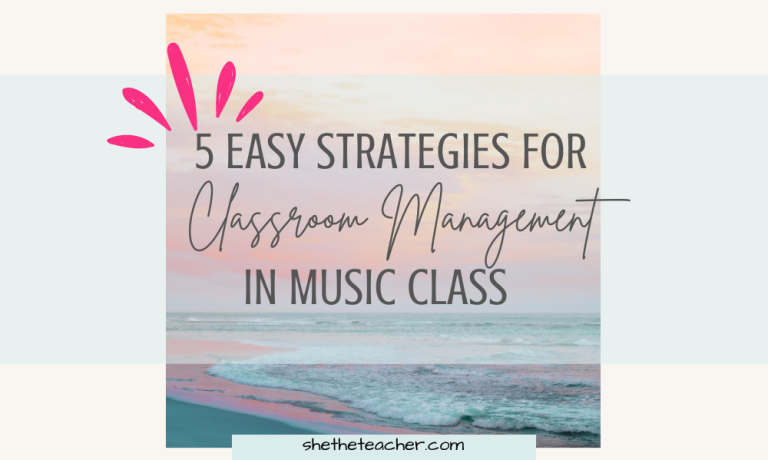
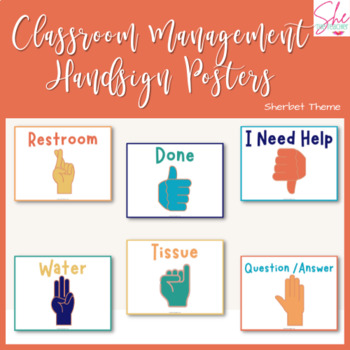

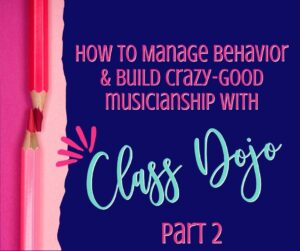
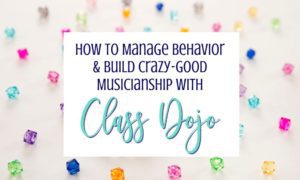
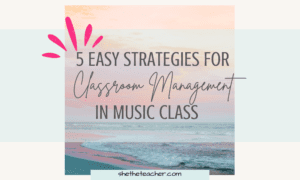
One Response
Thank you so much for sharing this article! Love how you included sharing the classroom jobs because it also teaches them independence and instills a sense of responsibility.